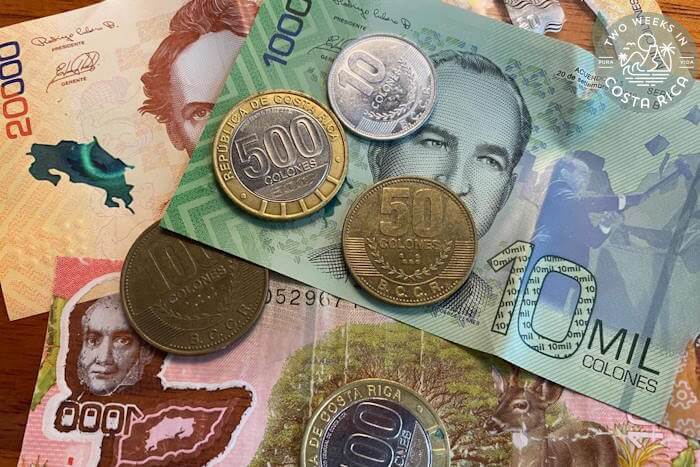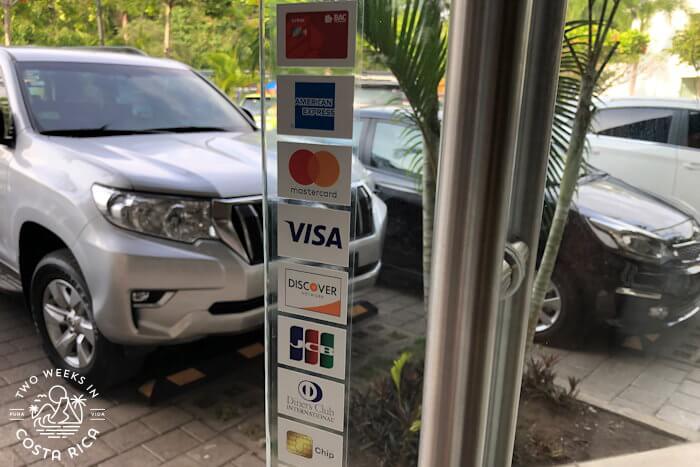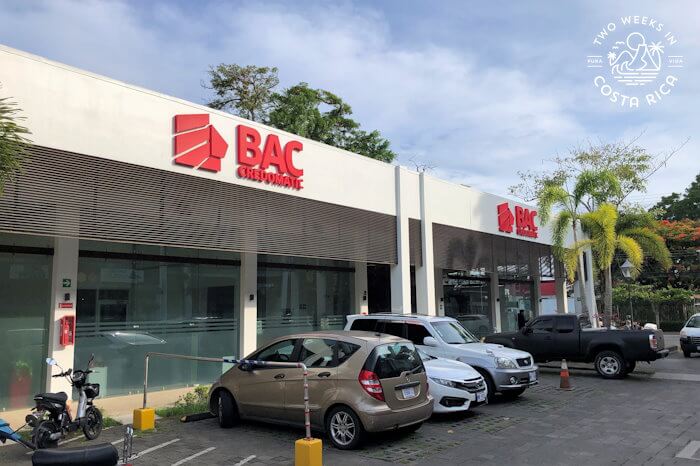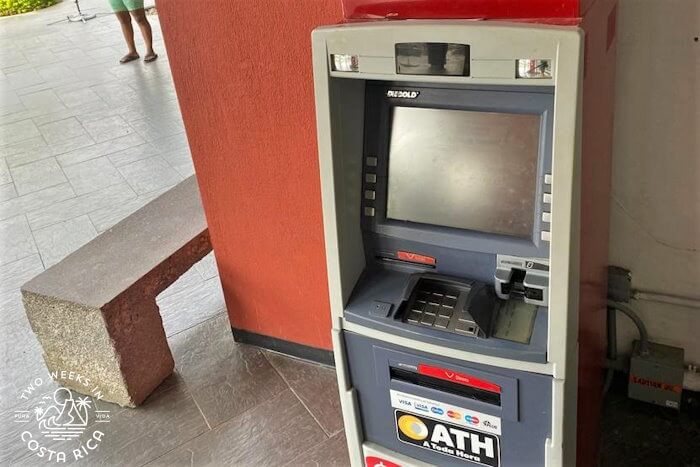One of the biggest questions people have when traveling to Costa Rica is how they will pay for things once they arrive. In this post, we’ll explain where and when you can use your credit card or debit card. We’ll also go through how to take money out of a local ATM so that you have some cash as well.

Money in Costa Rica
Costa Rica’s official currency is the colon. US dollars are also in circulation and available at local banks.
Colones are what most people living in the country use when buying groceries, everyday items, paying for services, etc.
Some things in Costa Rica are priced in US dollars. For example, it is very common for hotels, tours, and transportation services to be in dollars. This is because, historically, Costa Rica has received the most tourists from the United States.
Souvenir shops and restaurant menus may be priced in colones, dollars, or both, depending on how touristy the area is.
The exchange rate fluctuates daily. As an example, it can be around 560 colones = $1 (USD). For tips on finding the current exchange rate and converting from dollars, read our post, Costa Rica’s Exchange Rate: Quick Tips and Tricks.

For lots more information about the currency, read our post, Currency, Exchanging Money, and Tipping in Costa Rica.
Using Credit Cards or Debit Cards in Costa Rica
Our best advice when traveling in Costa Rica is to use your credit card or debit card whenever possible.
When you make a purchase in colones with your card, you’ll get the exact bank exchange rate for that day. This prevents errors calculating the exchange rate, and thus, merchants from overcharging you based on an exchange rate that they made up.
Using a card also allows you to travel with less cash, which is safer and easier.
Where are Cards Accepted?
Credit/debit cards are widely accepted in Costa Rica, even at very small businesses. It is easy to use cards at restaurants, hotels, tour offices, grocery stores, convenience stores, and most shops. Even toll booths on Costa Rica’s highways now accept cards.
Occasionally, card processing machines in very rural areas may not work because they cannot connect to the Internet (3G/4G) signal. In this case, it’s good to have some cash as a backup.
A few locations where credit cards are not as widely accepted are Tortuguero, Drake Bay, and Cabo Matapalo (Osa Peninsula).
Types of Cards Accepted
Most businesses in Costa Rica will accept Visa or Mastercard. Not many accept Discover or American Express.
Debit cards are typically accepted in the same way as credit cards. One exception is rental cars. Rental car agencies require a credit card so that they can put a temporary hold on your card for the deposit. A debit card will not work.
Most card readers in Costa Rica offer the tap-to-pay option (using the card’s chip), but some still have you insert your card.

Foreign Transaction Fees
It is important to check with your credit or debit card company before your trip to find out about any fees.
You’ll also want to notify them that you will be traveling abroad to prevent transactions from being flagged as fraud. It’s no fun calling your bank from abroad to clear things up, especially on your vacation. You have better things to do!
The most common fees from purchases made in Costa Rica are foreign transaction fees.
These vary by card issuer but typically range from 1-5% of the purchase amount. That means if you spend $100, the final purchase price could range from $101 to $105, depending on your bank’s foreign transaction fees.
Tip: Many banks offer travel credit cards that do not have any foreign transaction fees. These cards often have other benefits too, like extra reward points on travel purchases. If you have enough time before your trip, it is worth looking into these options.
Extra Fees from the Merchant
Occasionally, a merchant in Costa Rica will accept credit or debit cards but tell you that there is an extra 3-5% charge for using one. This covers the merchant’s processing fees; the fees the bank charges them on each transaction. This is not that common but can happen, especially with smaller stores and operators.
Using ATMs in Costa Rica
Having some cash on hand is important during your trip. Rather than exchanging currencies before you arrive or at the airport (which usually has a bad rate), we recommend using a local ATM to withdraw cash with your debit card.
Where to Find ATMs
An ATM in Costa Rica is called a Cajero Automatico. These are usually located outside banks, in large malls, and in some shopping plazas or grocery stores. Both SJO and LIR Airports have ATMs as well.
In popular tourist destinations, you’ll find at least a few banks and ATMs. In rural settings there may be only one option that you have to drive to.
What Banks Have ATMs in Costa Rica?
In Costa Rica, you will not find a Bank of America ATM or Citibank ATM sitting on every corner. Instead, ATMs are associated with Costa Rica’s local banks.
The two biggest banks in Costa Rica are Banco Nacional and Banco de Costa Rica.
Other larger banks include Banco Popular, Banco BAC Credomatic San Jose, Banco Davivienda, and Banco Promerica. Scotiabank also has some ATMs around the country. There are many smaller banks too.

ATM Machine Language
All ATM machines in Costa Rica default to Spanish. However, there is usually an option for English. If not, you can probably get through the menu knowing a few words and terms.
Tarjeta (card)
Contrasena (password/pin)
Retirar (withdraw)
Saldo (balance). Consulta de saldo (balance inquiry)
Cuenta corriente (checking account)
Cuenta ahorros (savings account)
ATM Currencies
ATMs in Costa Rica normally dispense both colones and US dollars.
In some rural areas they may have machines that only dispense colones, since the locals in those areas don’t use dollars very much.

ATM Fees in Costa Rica
Like most places, if you are using an ATM out of your normal network, the local bank will charge a fee. In Costa Rica, these fees typically range from 1,500-3,000 colones (about $3-6). You also may get charged from your bank.
Like with credit cards, you can be charged others fees from your bank at home as well. Many banks have a currency conversion fee for taking out foreign currency. Check with your card issuer.
If you plan to spend a lot of time in Costa Rica, it could be worth getting a debit card that doesn’t charge fees. For example, we have a Capital One debit card that doesn’t charge any fees for using an out-of-network ATM, including outside the United States. It also doesn’t charge for taking out colones.
Tip: Bank of Costa Rica (BCR) ATMs do not charge a fee on their end. By using a BCR ATM, you can reduce your overall fees or have no fees at all depending on your card issuer. One caveat is that BCR ATMs only allow you two transactions of 50,000 colones per day (100,000 colones or around $200 (USD) total per day). Other banks allow higher withdrawal amounts but do charge ATM fees.
ATM Safety
Just like anywhere in the world, you have to be cautious and smart about withdrawing money. Always make sure you are in a safe area and try not to visit the ATM at late hours. Never ask a local to help you through the menu, since they can collect personal information like your pin. Use common sense and be aware of your surroundings.
Conclusion
Using your credit card or debit card for purchases in Costa Rica can make your travels easier and stress free. Taking out money from ATMs as you go is also a good option. Both ensure that you don’t have to carry large sums of money around with you. This way, you can focus on having a fun and relaxing vacation!
Have a question about credit cards or ATMs in Costa Rica? Leave us a comment below.
Looking for more practical information for your trip? Check out these posts:
Packing for Costa Rica: The Essentials – This packing list covers what you’ll need in some of Costa Rica’s different climates. Check it out to see if you’ve forgotten anything.
Money Matters: Currency, Exchanging Money, and Tipping in Costa Rica – More on everything money, including tipping and taxes.
Simple Spanish for Visiting Costa Rica – This short guide will give you some key words and phrases to help you get around.
